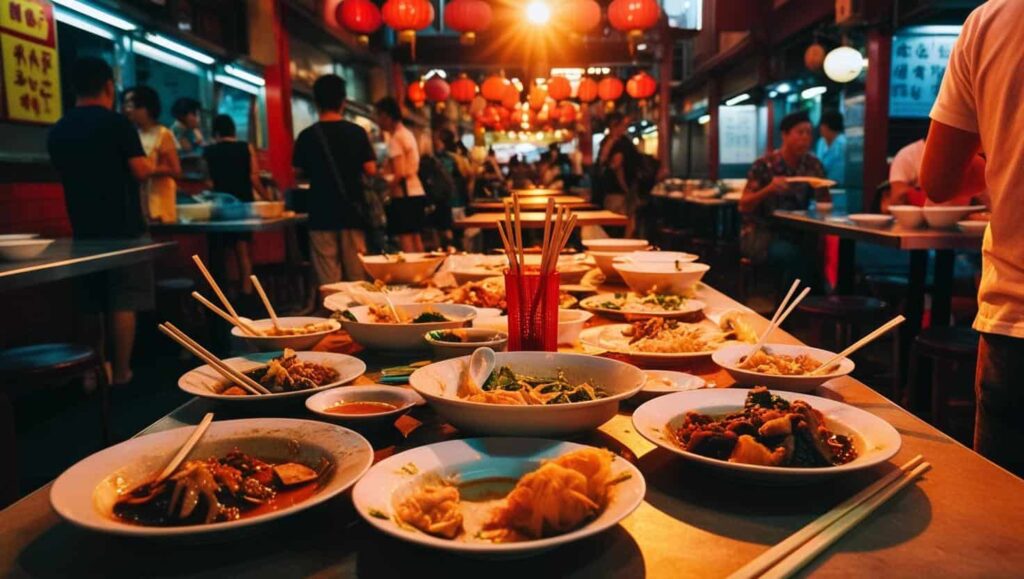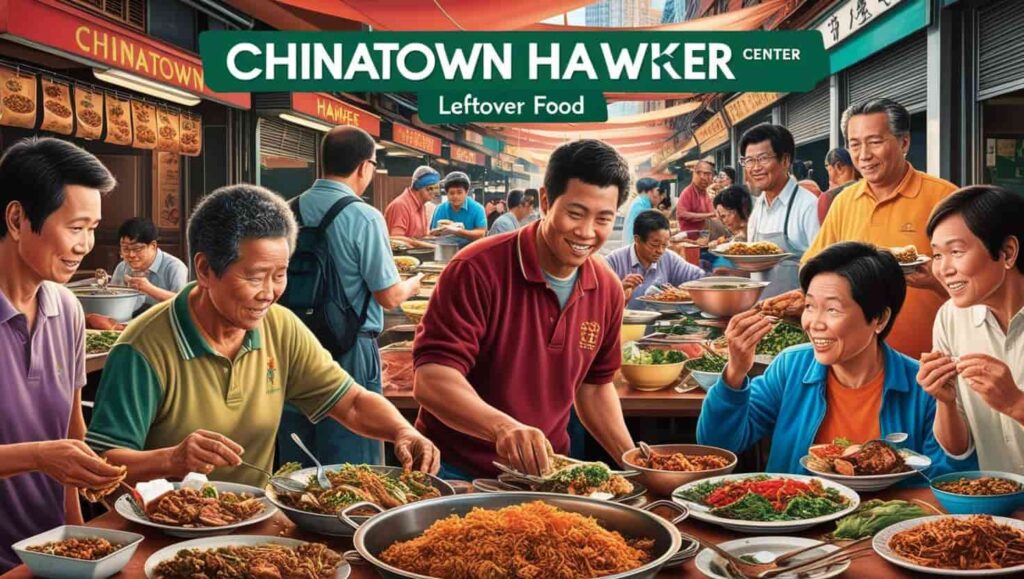Introduction
In recent years, a surprising trend has been emerging from the streets of Chinatown hawker centers: the reuse and consumption of hawker leftovers. While food waste is a global issue that many are working to address, Chinatown hawker leftovers consumption has become a unique practice, blending cultural traditions, sustainability efforts, and economic realities.
This trend is not just about saving food—it’s about rethinking how we perceive and handle leftovers in one of the most vibrant food hubs of the world.
In this article, we will explore Chinatown hawker leftovers consumption, its origins, the societal and environmental implications, and how this practice is stirring conversations about food sustainability in local communities.
What Are Chinatown Hawker Centers?
To understand the trend of Chinatown hawker leftovers consumption, it’s essential to first understand what a hawker center is.
Hawker centers are food courts commonly found in Singapore and other Southeast Asian countries, especially in Chinatown districts. These centers are known for offering a variety of affordable, authentic, and local food, often prepared by skilled street vendors or hawkers.
The atmosphere is bustling, with the rich smells of various dishes filling the air, and people from all walks of life coming together to enjoy a quick, hearty meal.
While hawker centers are a celebrated part of local culture, they also face challenges related to food waste. The sheer volume of food prepared, the often large portion sizes, and the busy nature of these food hubs can lead to a significant amount of leftovers.
Traditionally, these leftovers would simply be thrown away, contributing to the ever-growing issue of food waste.
The Rise of Chinatown Hawker Leftovers Consumption
The idea of reusing Chinatown hawker leftovers consumption has recently gained traction in response to both the environmental concerns surrounding food waste and the increasing costs of living. For many, especially in the Chinatown community, food is too valuable to waste.
As a result, new practices have emerged to ensure that leftovers do not end up in the trash, but instead find their way into the hands of those who can use them.
Some hawker vendors have started selling their unsold food at discounted prices towards the end of the day.
This practice is gaining popularity because it provides an affordable alternative for people looking to save money while enjoying quality food.
Additionally, some hawker centers are partnering with community organizations to redistribute leftovers to the needy.
These initiatives help combat both food waste and hunger, making Chinatown hawker leftovers consumption a practice rooted in social responsibility.
The Environmental Impact of Food Waste

Food waste is a global issue, and it has significant environmental consequences. Food waste accounts for a large portion of greenhouse gas emissions, contributing to climate change.
In Singapore, for example, about 700,000 tonnes of food are wasted annually, much of which comes from the food service industry, including hawker centers.
The practice of Chinatown hawker leftovers consumption plays a key role in addressing this issue. By reusing leftovers, hawkers reduce the need to discard perfectly good food.
This helps minimize the carbon footprint associated with food production, transportation, and disposal. Moreover, it encourages a shift in consumer behavior, from a mindset of abundance to one that values sustainability and waste reduction.
Rather than seeing leftover food as waste, people are beginning to see it as a resource. This shift in perspective has the potential to inspire similar practices in other parts of the world, making Chinatown hawker leftovers consumption not only a local trend but also a model for global change.
Social Responsibility and Community Involvement
The trend of Chinatown hawker leftovers consumption is also deeply tied to social responsibility. Many hawkers see their food as more than just a business venture—they view it as a way to support their local community.
By reducing food waste and redistributing leftovers, they can contribute to alleviating hunger in their area.
Organizations such as food banks and charity groups are stepping in to facilitate the donation of these leftovers. This creates a win-win situation for both the hawker vendors and the community.
Vendors can reduce their waste and potentially offset some of their costs, while the community benefits from access to affordable meals.
In many ways, this practice is reshaping the relationship between food businesses and their surrounding neighborhoods.
Moreover, Chinatown hawker leftovers consumption highlights the importance of community involvement in sustainable practices.
Residents are increasingly supporting this trend by embracing it as a way to reduce their own environmental impact while helping those in need.
Economic Benefits of Reusing Leftovers
In addition to the environmental and social benefits, there are also economic advantages to Chinatown hawker leftovers.
For hawker vendors, reducing food waste means lower operating costs. When leftovers are consumed rather than thrown away, vendors experience less financial loss from unsold food.
For customers, purchasing discounted leftover food is a cost-effective way to enjoy a satisfying meal. This is particularly important in urban areas like Chinatown, where the cost of living is high, and affordable meal options are highly sought after.
Chinatown hawker leftovers consumption offers an alternative for budget-conscious consumers, ensuring that they can continue to enjoy their favorite dishes without breaking the bank.
Furthermore, the practice creates opportunities for new businesses and startups focused on sustainable food practices.
Companies that specialize in food waste reduction, composting, or meal redistribution are finding a growing market for their services. This, in turn, helps stimulate the local economy and supports the growth of green businesses.
Public Awareness and Cultural Shifts
As Chinatown hawker leftovers consumption continues to gain popularity, there is a noticeable shift in public awareness regarding food waste.
What was once considered taboo is now seen as a viable and necessary practice. Hawker vendors are becoming more transparent about their efforts to reduce waste, and customers are increasingly conscious of the impact their food choices have on the environment.
In many ways, this trend is challenging traditional attitudes about food. The idea of wasting food is no longer acceptable, and people are starting to recognize the value of leftovers.
Through social media and word of mouth, the message is spreading that Chinatown hawker leftovers consumption is not only a clever way to fight food waste but also a sustainable lifestyle choice.
The trend is also prompting changes in how food is prepared and served. Many hawkers are adjusting portion sizes and offering more flexible pricing options, allowing customers to buy only what they need and reducing the likelihood of excess food being left over.
This not only helps reduce waste but also improves the overall dining experience for customers, who can enjoy meals that are both affordable and tailored to their needs.
Challenges and Future Prospects
While Chinatown hawker leftovers consumption offers a promising solution to food waste, there are still challenges to overcome.
One of the primary concerns is ensuring food safety. Leftover food, particularly in hot and humid climates like Singapore, can pose health risks if not stored and handled properly.
To address this, hawker vendors must adhere to strict hygiene standards and ensure that leftovers are stored at safe temperatures.
Another challenge is overcoming cultural stigma. In some cultures, leftovers are viewed as inferior or undesirable. Changing this mindset requires ongoing education and awareness campaigns that highlight the environmental, social, and economic benefits of reusing food.
Despite these challenges, the future of Chinatown hawker leftovers consumption looks bright. With continued support from the community, local businesses, and organizations, this trend has the potential to become a standard practice in Chinatown and beyond.
As consumers become more environmentally conscious and socially responsible, the reuse of hawker leftovers could pave the way for a more sustainable food system globally.
Conclusion
In conclusion, Chinatown hawker leftovers consumption represents a refreshing and innovative approach to tackling the issue of food waste.
By rethinking how we treat leftovers, hawker vendors, customers, and the community as a whole are contributing to a more sustainable and socially responsible food system.
The trend not only helps reduce environmental impact but also promotes economic benefits, community involvement, and public awareness.
As more people embrace the idea of reusing hawker leftovers, this practice could set an example for other food hubs around the world.
Through collective effort and cultural shifts, Chinatown hawker leftovers consumption can play a significant role in creating a more sustainable future, one meal at a time.


